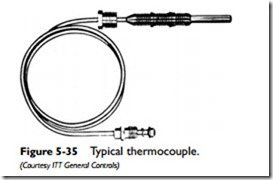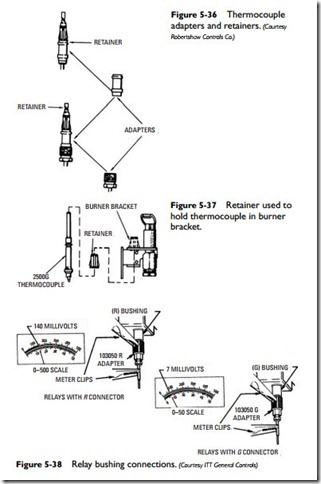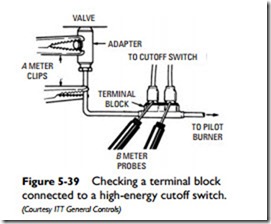Thermocouples
The function of the thermocouple is to detect (prove) the existence of the pilot flame. If the pilot light is lit and the thermocouple detects the pilot flame, it opens the main gas valve and allows natural gas to flow to the burner(s). If there is no pilot flame, the thermocouple shuts off the gas to the pilot and closes the main gas valve so that no gas can flow to the burner(s).
Thermocouples are made from flame-resistant metal alloys and are available in standard lengths of 13.5 to 48 inches (see Figure 5-35). Industry-standard G bushing or R bushing threads are used for connecting the thermocouple to the valve. Thermocouples from the various manufacturers can also be interchanged. The thermocou- ples manufactured by ITT General Controls, Robertshaw-Grayson, Baso, Honeywell and others are designed for universal installation when used with the proper adapter and retainer (where required) (see Figures 5-36 and 5-37).
Always test the thermocouple before replacing it. The problem with the pilot flame or safety control may be caused by something other than a malfunctioning thermocouple.
Manufacturers of thermocouples generally provide a special adapter for testing thermomagnet valves. The adapter is screwed into the gas valve, the thermocouple (or generator) leads into the adapter, and the test is run as follows:
1. Attach the meter clips as shown in Figure 5-38. Reverse the meter clips if the needle moves to the left of zero on the millivoltmeter.
2. A meter reading of less than 7 millivolts for thermocouples or less than 140 millivolts for pilot generators indicates the orifice and primary air holes on the pilot burner need to be cleaned.
Sometimes a thermocouple will have a terminal block connected to a high-energy cutoff switch. The millivoltage should be checked with meter probes as shown in Figure 5-39. The various readings suggest the following courses of action:
• Replace the high-energy cutoff switch if the reading exceeds 4 millivolts.
• Replace the thermocouple if the reading is still less than 7 millivolts.
• Replace (or repair) the valve if it fails to hold open with a meter reading of more than 7 millivolts.


